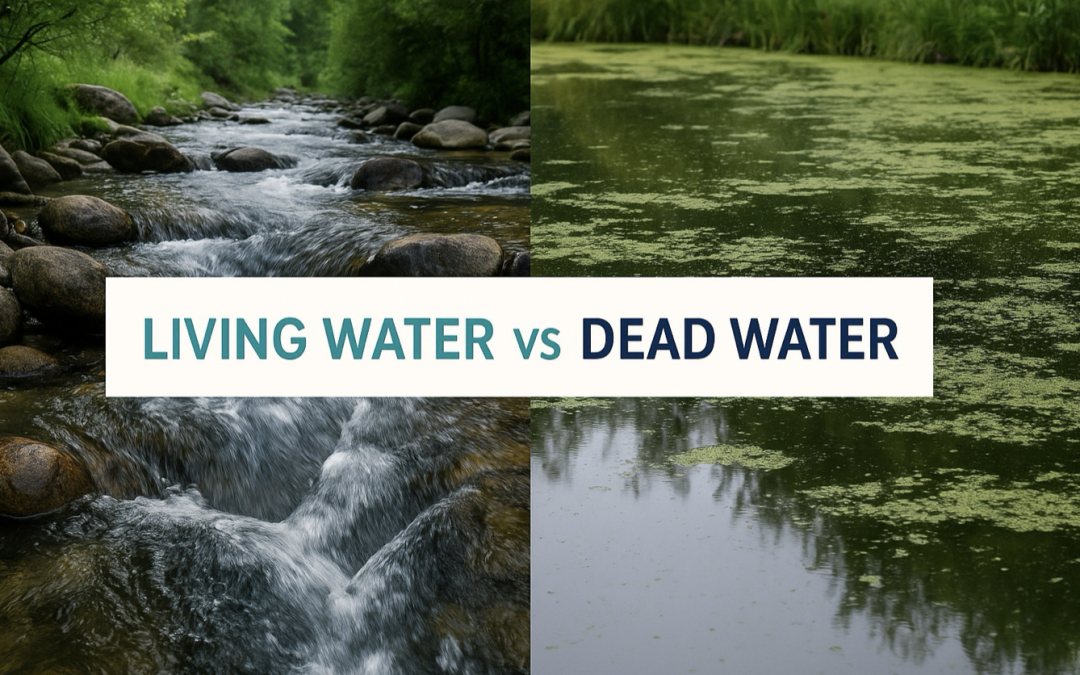When people say “living water,” they usually mean water that feels fresh, flowing, spring-like, and tasty. “Dead water” often means flat, lifeless, over-processed or stagnant water. Those words sound powerful, but they don’t map to any official safety standard. What matters for your health and your plumbing is microbiological safety, balanced minerals, and good system design that keeps water moving.
1) The Old Meaning: Flowing vs Stagnant
Historically, living water meant moving water—springs, streams, fountains. Dead water meant stagnant pools or cisterns. That old language still makes sense from a hygiene point of view: moving water tends to be fresher, while water that sits too long can lose disinfectant and become a home for biofilms.
Takeaway: Flow beats stagnation. In buildings, that means avoiding dead legs, maintaining hot-water recirculation, and flushing seldom-used taps.
2) The Wellness Meaning: “Structured,” “Energised,” “Hexagonal,” “EZ Water”
Modern marketing often uses living water for things like structured or energised water, sometimes with claims about “hexagonal clusters,” “negative ORP,” or “H₃O₂.” The flip side is calling RO or distilled water dead.
What we tell clients:
There is no recognised drinking-water standard that requires “structured” water.
Safety and performance are measured by SANS 241:2015 parameters, not by buzzwords.
If your RO water tastes flat or feels “lifeless,” it’s usually because the minerals and alkalinity are very low, which affects taste and can make water more corrosive to pipes and appliances.
Good news: You can make RO water feel “alive” again by remineralising and balancing it for taste and stability.
3) The Water-Treatment Meaning: “Dead” = Over-Aggressive, “Living” = Balanced
In practical treatment work, technicians sometimes call very low-TDS water “aggressive” or “hungry.” It can dissolve metal ions and scale, and it often tastes bland. Balanced, remineralised water feels rounder on the palate and behaves better in plumbing.
Targets H₂OGuru likes for household RO product water
pH: 7.2 to 8.0
Alkalinity: 40 to 80 mg/L as CaCO₃
Calcium: 20 to 50 mg/L
Magnesium: 10 to 30 mg/L
TDS (taste window): ±80 to 250 mg/L
These aren’t legal limits. They’re practical ranges for stability and taste.
4) Where People Get Tripped Up
“Raw spring water is living so it must be healthier.”
Not necessarily. Untreated water can carry pathogens. For drinking, safety beats romance.
“RO is dead so it’s bad for you.”
RO is a tool. If you remineralise and stabilise the product water, it becomes excellent for both health and appliances.
“Add oxygen, change ORP, job done.”
Dissolved oxygen and ORP are not health criteria in SANS 241 for potable water. Focus on compliance, taste, and corrosion control.
5) Plumbing Design: Make Water “Live” by Keeping It Moving
Even perfect water turns “dead” if it sits. In buildings, dead legs (long branches to rarely used taps), capped tees and long loops create stagnation pockets. The fix is simple:
Design for flow-through: looped or recirculated hot water, short branches to outlets.
Avoid blind ends: remove or flush them on a schedule.
Temperature control: keep hot water hot and cold water cool.
Documented flushing: especially for seldom-used outlets.
6) H₂OGuru’s Position
We don’t sell magic water. We deliver safe, compliant, great-tasting, infrastructure-friendly water, and we can prove it.
Our promise in three lines
Safety: SANS 241 microbiology and chemistry, verified by accredited labs.
Stability & Taste: RO when needed, then remineralisation to hit sensible Ca/Mg/alkalinity targets.
System Health: Design that avoids stagnation, plus simple maintenance routines.
7) How to Tell if Your Water Feels “Dead” and What to Do
Common signs
Flat taste, metallic aftertaste, chalky kettle residue or the opposite, etching and pinhole leaks.
Blue-green staining (copper corrosion) or frequent scale-and-sludge issues.
“First draw” water tastes different to mid-flow.
Quick wins
Test properly against SANS 241 and basic indices.
If RO, add a calcite/dolomite contactor or a controlled remineralisation stage.
Balance your hot-water recirculation and shorten long branches.
Flush little-used outlets on a schedule.
FAQ
Is “living water” a legal category?
No. It’s a description, not a standard. Potable water in South Africa is judged against SANS 241:2015.
Is RO bad because it removes minerals?
No. RO removes contaminants. You can add back the right minerals and alkalinity for taste and stability.
Do I need “structured water”?
There’s no regulation or strong evidence that you do. If your goal is health, taste and appliance protection, focus on compliance and remineralisation.
Book a Sample-to-Solution test with H₂OGuru. We’ll test to SANS 241, interpret the results in plain English, and design a balanced treatment that delivers safe, great-tasting water with zero gimmicks. Contact Us Today.

